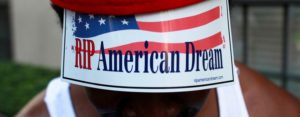
A study from William G. Gale, Melissa S. Kearney, and Peter R. Orszag at the Brookings Institution, the liberal-centrist think tank, asked the following question, which is the title of their report: “Would a significant increase in the top income tax rate substantially alter income inequality?” The answer they came up with is, no.
The Brookings study involved a simulation exercise to examine how the distribution of post-tax income would change under three scenarios: 1) A tax schedule raising the top individual income tax rate from 39.6 percent to 45 percent; 2) Raising the top individual income tax rate from 39.6 percent to 50 percent, and 3) Raising the top individual income tax rate to 50 percent for income over $1 million for joint filers and $750,000 for single filers.
To assess the impact of these reductions in after-tax income on overall inequality, the authors calculated the Gini coefficient for each of the three tax policy scenarios. The Gini coefficient, which is used to determine income inequality, “measures the extent to which the distribution of income (or, in some cases, consumption expenditure) among individuals or households within an economy deviates from a perfectly equal distribution,” according to the World Bank. The Gini coefficient ranges between 0 and 1, with 0 representing perfect equality in which everyone has the same income, 1 representing perfect inequality in which one person has all of the income.
Under current tax realities, the after-tax Gini coefficient was calculated at .574 compared with a pre-tax Gini of .610. However, under the first tax scenario, the Gini was reduced merely from .575 to .573. Under the second scenario, the Gini was reduced to .571, and under the third, the Gini was .572. In other words, there was scant impact in income inequality from the three tax scenarios.
“That such a sizable increase in top income tax rates leads to such a limited reduction in income inequality speaks to the limitations of this particular approach to addressing the broader challenge,” the authors wrote. “To be sure, our results do not speak to the general desirability of a more progressive tax-and-transfer schedule, just to the fact that even a significant tax increase on high-income households and corresponding transfer to low-income households has a small effect on overall inequality.”
Not surprisingly, the conservative, pro-business American Enterprise Institute agreed with the results of the Brookings study. Writing for AEI, blogger James Pethokoukis suggested that reducing inequality does not come through progressive taxation or raising the minimum wage, but rather through investing in education, addressing surging real estate prices. Pethokoukis also agrees with Orszag that pay inequality is on the rise because some firms pay much better than others.
However, writing for the progressive Daily Kos blog, John Perr raises an issue that both Brookings and AEI neglect to mention.
“One of the most important causes of the dramatic upward redistribution of wealth underway since the early 1980’s,” he writes. “Simply put, the richest one percent of Americans make most of their money from investments. And the tax rates on their gains are now only about half the level they were when Ronald Reagan first took the oath of office.”
Perr referenced a September 2011 Washington Post series called “Breakaway Wealth” which showed how sinking capital gains and dividend tax rates created a concentration of wealth and income gap not witnessed since the Great Depression. The Washington Post said the capital gains tax cuts under President Clinton (from 28 to 20 percent in 1998, and President Bush (from 20 to 15 percent in 2003) were “better than any Christmas gift.” The Post report elaborated:
While it’s true that many middle-class Americans own stocks or bonds, they tend to stash them in tax-sheltered retirement accounts, where the capital gains rate does not apply. By contrast, the richest Americans reap huge benefits. Over the past 20 years, more than 80 percent of the capital gains income realized in the United States has gone to 5 percent of the people; about half of all the capital gains have gone to the wealthiest 0.1 percent.
Perr also mentioned that in 2012, according to the New York Times, the top 10 percent of earners took home more than half of the nation’s income, a national record, as the “stratospherically rich” are distinguishing themselves from the “merely rich” and leaving everyone else behind. Further, a 2013 Congressional Research Service study confirmed that historically low capital gains tax rates are “by far the largest contributor” to record high income inequality in the U.S.
ThinkProgress clarified and elaborated on these findings, noting that the spiraling increase in income inequality as measured by the Gini coefficient between 1991 and 2006 is primarily due to federal tax policy, in which capital gains and dividend income tax rates were slashed, income which is reserved for the rich.
Meanwhile, to put in perspective the issue of economic inequality and the accumulation of wealth by some at the expense of others, consider that in calculating the amount of damages for slavery reparations, estimates have ranged from $6 trillion to nearly $60 trillion.


